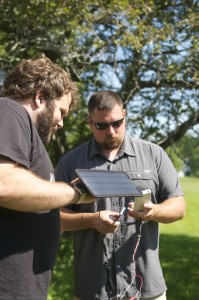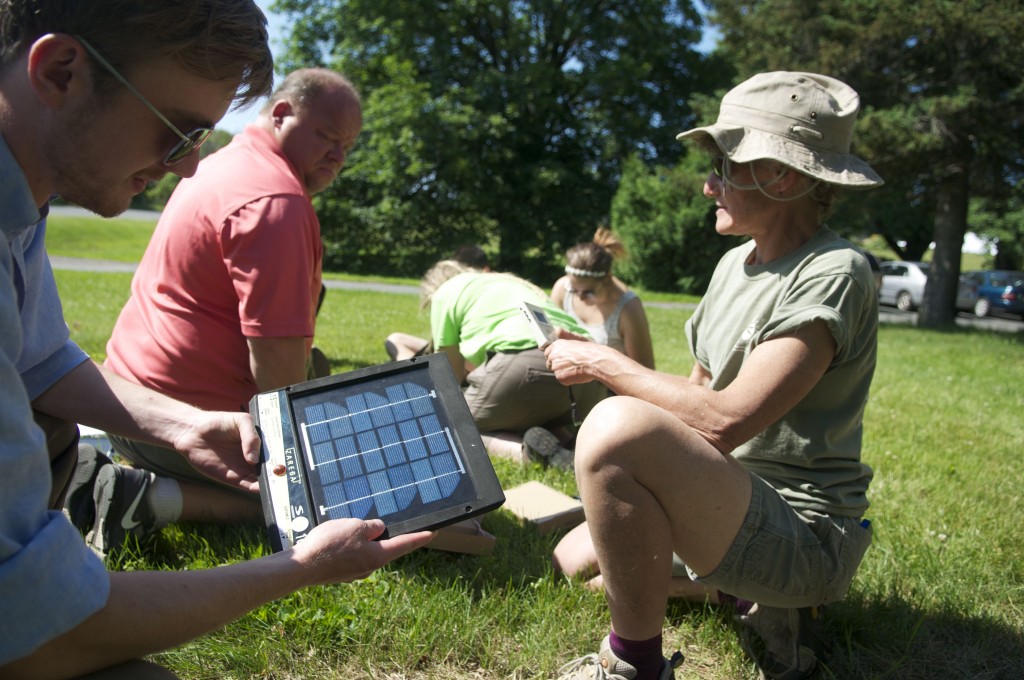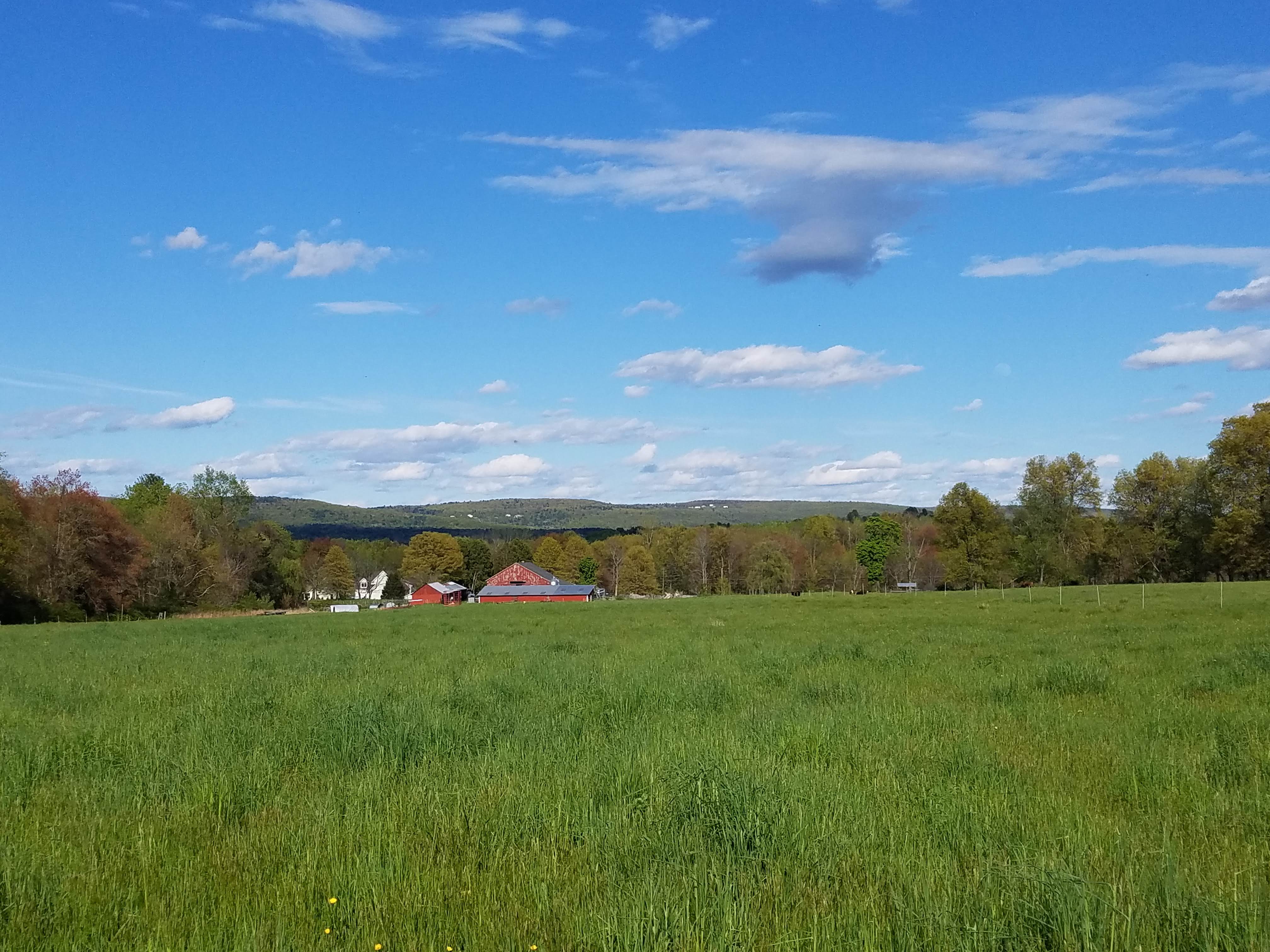Guest Post by Joshua Minot F12
From June 8th through 18th, Hampshire College was home to a National Science Foundation supported course that explores topics of sustainable agriculture, renewable energy, and manners in which the two can compliment each other. As part of a broader six-week course in partnership with Holyoke Community College and The University of Massachusetts Amherst, the time spent at Hampshire served to provide students with hands on experience with multiple clean energy technologies and the process of designing a clean energy system that could be incorporated into a small to medium sized farm. The students left Hampshire well equipped to navigate many of the key considerations farmers face when installing renewable energy production systems, and even gained experience presenting system proposals to farm staff.
 The course began with a brief review of important information related to generation of electrical and thermal energy—such as quantifying everyday energy use in terms of Kilowatt-hours or BTUs and exploring how greater energy efficiency can be achieved on farms. Steve Roof, professor of earth and environmental sciences at Hampshire, lead the class for this portion of the course and supported students with knowledge he has gained through his work on photovoltaic projects. Professor Roof has worked closely on Hampshire College initiatives involving solar power, and was able to introduce students to the unique considerations for photovoltaic power generation on campus, and more specifically at the Hampshire College Farm. Throughout the two-week session at Hampshire the Farm was used as a model for students to investigate power usage and system design principles. After touring the farm the students quickly moved on to estimating the power usage of the five main buildings at the farm center. This provided an eye opening experience in terms of how much energy even a modest sized farm can use, and the effects that both seasonality and management practices can have on a farm’s energy usage.
The course began with a brief review of important information related to generation of electrical and thermal energy—such as quantifying everyday energy use in terms of Kilowatt-hours or BTUs and exploring how greater energy efficiency can be achieved on farms. Steve Roof, professor of earth and environmental sciences at Hampshire, lead the class for this portion of the course and supported students with knowledge he has gained through his work on photovoltaic projects. Professor Roof has worked closely on Hampshire College initiatives involving solar power, and was able to introduce students to the unique considerations for photovoltaic power generation on campus, and more specifically at the Hampshire College Farm. Throughout the two-week session at Hampshire the Farm was used as a model for students to investigate power usage and system design principles. After touring the farm the students quickly moved on to estimating the power usage of the five main buildings at the farm center. This provided an eye opening experience in terms of how much energy even a modest sized farm can use, and the effects that both seasonality and management practices can have on a farm’s energy usage.
 With a greater understanding of the energy demands of a farm, the students went on to experiment with portable photovoltaic panels—this exercise was an opportunity to learn how factors such as panel shading, orientation, and angle can significantly impact the power generation capacity of a photovoltaic system. This knowledge allowed students to quickly gain insights on the diverse set of considerations that must be taken into account when conducting site assessments and designing systems for a specific application. Farm center staff members were interviewed during this process to provide the students with an idea of how customer requirements may impact the final form of a system. Students gained additional insight from Hampshire Alum Adam Thurrell 97F, who is head of Commercial Sales at local solar company PV Squared. Thurrell conducted a guest lecture for the course, and discussed topics such as mounting options, rule-of-thumb pricing for quick estimates, the economics of solar in agricultural settings, and public incentives available to consumers and farmers.
With a greater understanding of the energy demands of a farm, the students went on to experiment with portable photovoltaic panels—this exercise was an opportunity to learn how factors such as panel shading, orientation, and angle can significantly impact the power generation capacity of a photovoltaic system. This knowledge allowed students to quickly gain insights on the diverse set of considerations that must be taken into account when conducting site assessments and designing systems for a specific application. Farm center staff members were interviewed during this process to provide the students with an idea of how customer requirements may impact the final form of a system. Students gained additional insight from Hampshire Alum Adam Thurrell 97F, who is head of Commercial Sales at local solar company PV Squared. Thurrell conducted a guest lecture for the course, and discussed topics such as mounting options, rule-of-thumb pricing for quick estimates, the economics of solar in agricultural settings, and public incentives available to consumers and farmers.
 With all of these factors taken into account, groups of students set out to design a system that could meet the energy demands of the farm center. To conclude this portion of the course, the groups presented their final designs to Hampshire’s Food, Farm, and Sustainability Director (and co-facilitator of the course) Beth Hooker—who was able to provide feedback from the perspective of a potential customer.
With all of these factors taken into account, groups of students set out to design a system that could meet the energy demands of the farm center. To conclude this portion of the course, the groups presented their final designs to Hampshire’s Food, Farm, and Sustainability Director (and co-facilitator of the course) Beth Hooker—who was able to provide feedback from the perspective of a potential customer.
Read Part II: NSF students investigate wind power and solar thermal technologies»


Pingback: Food, Farm, and Sustainability » Clean Energy Technology & Sustainable Agriculture course offered this summer